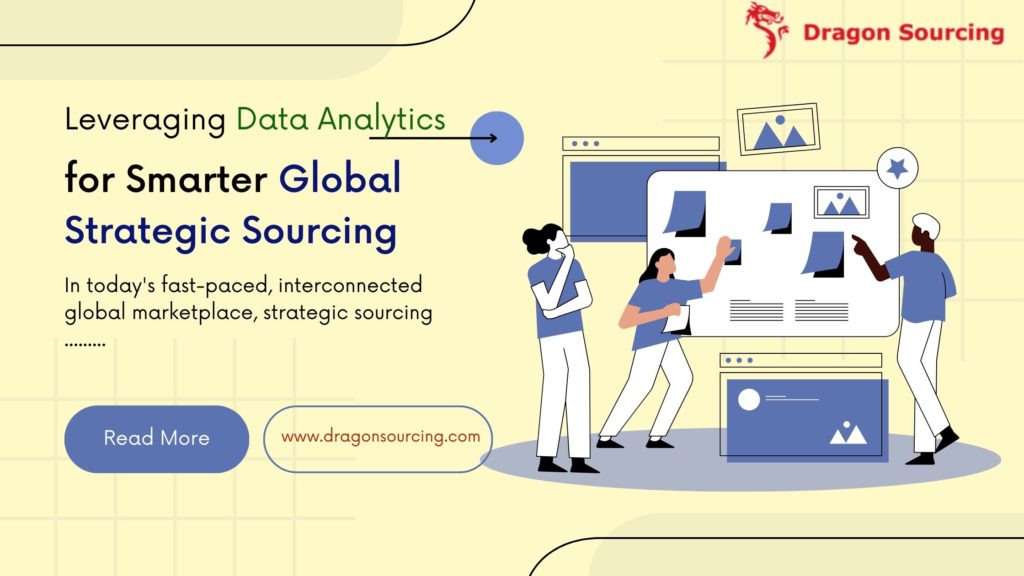
Synopsis:
-
Global strategic sourcing focuses on long-term value over short-term cost savings.
-
Data analytics enhances procurement through insights into spend, supplier performance, and risk.
-
Key applications include spend analysis, demand forecasting, and market intelligence.
-
Benefits: smarter decisions, cost savings, stronger supplier relationships, and supply chain resilience.
-
Challenges include data silos, quality issues, and skills gaps.
-
To start: define goals, audit data, choose tools, build teams, and scale gradually.
-
Real-world success shows how analytics can lead to multi-million-dollar savings and operational efficiency.
In today’s fast-paced, interconnected global marketplace, strategic sourcing has become more than just a cost-saving initiative. It’s now a vital part of long-term business strategy. With the exponential growth of data, businesses are increasingly turning to data analytics to transform how they approach global strategic sourcing. By leveraging data, companies can make more informed decisions, mitigate risks, identify savings opportunities, and build more resilient supply chains.
This blog explores how data analytics is revolutionizing global strategic sourcing and how organizations can harness its power to drive smarter procurement strategies.
What is Global Strategic Sourcing?
Global strategic sourcing is the process of identifying, evaluating, and engaging suppliers on an international scale to acquire goods and services that align with an organization’s long-term goals. Unlike traditional procurement, strategic sourcing emphasizes value over cost and takes into account factors such as quality, supplier reliability, risk mitigation, innovation, and sustainability.
In this context, data analytics serves as a game-changer. It provides procurement professionals with insights that were previously difficult to obtain, helping them optimize every stage of the sourcing process.
The Role of Data Analytics in Strategic Sourcing
Data analytics enables businesses to collect, process, and interpret large volumes of data to uncover patterns, trends, and insights. Here’s how it applies specifically to global strategic sourcing:
1. Spend Analysis
By aggregating and analyzing procurement spend data, organizations can identify where their money is going, who their top suppliers are, and where there are opportunities for consolidation or renegotiation. Tools like spend cubes and dashboards help visualize data to support decision-making.
2. Supplier Performance Evaluation
Analytics tools can track supplier KPIs, such as on-time delivery rates, defect rates, compliance records, and financial stability. This helps sourcing managers assess supplier risk and performance over time, ensuring more strategic supplier selection.
3. Market Intelligence
External data sources, including market trends, commodity prices, geopolitical updates, and currency fluctuations, can be integrated into procurement systems. This empowers procurement teams to make more proactive decisions based on real-time market conditions.
4. Demand Forecasting
By analyzing historical demand patterns and using predictive analytics, organizations can forecast future procurement needs more accurately. This ensures better inventory management and reduces the risk of over- or under-stocking.
5. Risk Management
Data analytics helps identify potential risks in the supply chain, such as over-reliance on a single supplier, political instability in supplier regions, or financial risks associated with a supplier. Early identification enables timely mitigation strategies.
Benefits of Using Data Analytics in Global Strategic Sourcing
Improved Decision-Making
With real-time data and predictive models, sourcing decisions are no longer based on intuition or past experiences. Procurement teams can make data-backed decisions that align with strategic goals.
Enhanced Supplier Relationships
Transparency and performance tracking enable more meaningful conversations with suppliers. Analytics can highlight areas for improvement and collaboration, fostering stronger partnerships.
Increased Cost Savings
By identifying inefficiencies, redundant purchases, and potential areas for negotiation, analytics can significantly reduce procurement costs.
Greater Agility and Resilience
In times of disruption, such as natural disasters or geopolitical conflicts, data analytics provides the visibility needed to respond quickly. Alternative suppliers can be identified, and contingency plans can be executed more effectively.
Challenges in Implementing Data Analytics for Strategic Sourcing
Despite its advantages, implementing data analytics in global strategic sourcing is not without challenges:
Data Silos and Integration
Procurement data often resides in multiple systems across departments or geographies. Integrating these datasets into a unified platform is essential but can be complex.
Data Quality
Inaccurate, incomplete, or outdated data can lead to faulty insights. Establishing data governance and quality control measures is critical.
Talent and Skills Gap
There’s a growing need for procurement professionals who are comfortable with data tools and analytics. Training or hiring talent with the right skills is necessary to fully leverage analytics.
Change Management
Organizations must cultivate a data-driven culture. This requires buy-in from stakeholders and a willingness to shift from traditional sourcing methods.
How to Get Started with Data-Driven Strategic Sourcing
Step 1: Define Clear Objectives
Start by identifying what you want to achieve with analytics—cost savings, risk mitigation, improved supplier performance, etc.
Step 2: Audit Your Data
Evaluate the current state of your procurement data. Identify gaps, clean the data, and ensure consistency across systems.
Step 3: Choose the Right Tools
Invest in procurement analytics software that integrates with your existing systems and supports your goals. Options include SAP Ariba, Coupa, Jaggaer, and IBM Emptoris.
Step 4: Build the Right Team
Combine procurement experts with data scientists or analysts to create a cross-functional team capable of interpreting and acting on insights.
Step 5: Start Small and Scale
Begin with a pilot project, such as a spend analysis in one category or region. Prove the value and gradually expand analytics initiatives across the organization.
Real-World Example: How a Global Retailer Optimized Sourcing with Data Analytics
A multinational retail company implemented a data analytics platform to analyze global spend across all business units. They discovered redundant suppliers, negotiated better pricing with high-volume vendors, and streamlined their supplier base.
The analytics tool also helped monitor supplier performance across regions, leading to improved delivery times and reduced defect rates. Within a year, the company saved millions in procurement costs and built a more resilient, data-informed sourcing strategy.
In the evolving world of global strategic sourcing, data analytics is not just a tool—it’s a necessity. From reducing costs and identifying risks to building stronger supplier relationships and boosting efficiency, the power of data is transforming procurement as we know it.
Organizations that embrace data analytics will not only enhance their sourcing strategies but also gain a competitive advantage in a rapidly changing global economy. The journey may require effort and investment, but the payoff is well worth it: smarter, faster, and more strategic sourcing decisions that drive long-term value.



